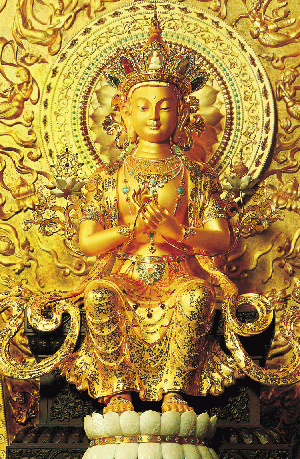Abhidharma - Third Baskets of Tipitaka
Abhidharma is some of the most important Buddhist texts which dated back to the ancient time that came to exist around 3rd BCE. Abhidharma is also known as Abhidhamma in Pali and contain some of the most important reworkings of most of Buddhist Sutras.
Abhidharma-Pitaka can be categorized as the third division or basket of the Tipitaka. The other remaining baskets of Tipitaka are Vinaya-Pitaka and Sutra-Pitaka. While these two baskets provide the practical knowledge and guidance for one to walk on the path of Buddha but the Abhidharma-Pitaka provides the theoretical knowledge on how the Buddhist teachings actually work. In the modern era, the Abhidharma can be explained in terms of two different texts. According to Tipitaka history, there were several other versions of Abhidharma-Pitaka but as the time goes by only two of these versions existed. These two different versions of Abhidharma are Sarvastivada Abhidharma and Theravada Abhidharma. The Sarvastivada Abhidharma is associated with texts of Mahayana Buddhism and Theravada Abhidharma is associated with texts of Theravada Buddhism.
Origin
The existence of Abhidharma can be found during the lifetime of Buddha. According to Buddhist tradition, Abhidharma came to exist after four weeks of Enlightenment. It is also mentioned that the Abhidharma can be considered as the earliest scripture that mentioned his thoughts. Seven years after attaining Enlightenment, Gautama Buddha preached about Abhidharma-Pitaka for about three months to Devas in the God realms (Deva Realms) which is one of the higher realms of six realms of the cycle of Life. It is also mentioned that he talked about Abhidharma to Sariputra, one of the chief disciples of Lord Buddha. According to Buddhist tradition, the Abhidharma was added to Tipitaka on the Third Buddhist Council that took place in 2nd Century BCE.
The philosophy of the origin of Abhidharma was also proposed by many scholars. Due to that there is a different version of this story. According to the scholars, the Abhidharma came to exist only after the time of Buddha. According to them, the Abhidharma represents the work of disciples and scholars who existed during the 3rd Century BCE and the development of Abhidharma was the output of the growing support of monastic orders and community such as Sangha. Some of the scholars claim that the final Buddhist texts of Theravada Abhidharma was completed around 5th Century CE and the final texts of Sarvastivada Abhidharma were completed around 4th Century CE but these dates are not certain to the present date. If taken roughly, both versions of Abhidharma came to exist in 3rd Century CE.
There are numerous numbers of debates on why the two versions of Abhidharma came to exist in the world of Buddhism. If the history of Mahayana and Theravada School of Buddhism is taken into account, then two versions of Abhidharma came to exist due to different doctrines of Buddhist texts. It is said that early group of Buddhist elders, who are known as Theravadins, rejected some of the teachings that Lord Buddha left behind. Sarvastivada used to be the sub-schools of Theravada during that time but later split away because they believe that they must consider all the teachings that Lord Buddha left behind. The Sarvastivada later influence Mahayana Buddhism.
Abhidharma-Pitaka
The Abhidharma Pitaka is the last of three Pitakas that constitutes to Pali Canon, one of the most popular scriptures of Theravada Buddhism. The Abhidharma Pitaka consists of different seven books. They are:
Dhammasangani
Dhammasangani is also known by the name "Enumeration of Phenomena". This book contains all the paramattha dhamma that can be found in the world. This book contains 52 mental factors, 89 different cittas, 4 primary physical elements and 23 physical phenomena that are believed to be derived from Nibbana.
Vibhanga
The second book of Abhidharma-Pitaka is Vibhanga which is also known as "The Book of Treaties". This book is about the analysis of the first book of Abhidharma, Dhammasangani.
Dhatukatha
The third book of Abhidharma is Dhatukatha and known by the name "Discussion with Reference to the Elements". It is the book which contains the questions and answers related with Dhammasangani.
4. Puggalapanatti
This fourth book of Abhidharma is describing of number of personality types and known by the name "Description of Personality".
5.Kathavatthu
Kathavathu book of Abhidharma contains three questions and answers that help to clarify the controversy that existed between the different Theravada Schools existed during that time. It is also known as "Points of Controversy".
6. Yamaka
The Yamaka book consists of ten chapters and each of these chapters deals with the different topic such as roots or create questions about "does someone understand the ear base who had already understood the eye base" etc. This book contains questions as well as answers so it name also refers as "The Book of Pairs".
7. Patthana
The Last book of Abhidharma is Patthana which is also known as "The Book of Relations". This book is by far the longest single volume in the Tipitaka and is about the 24 conditions to relation with Dharma or laws of conditionality.
The both versions of Abhidharma are the complicated texts of Buddhist texts and in order to study both versions, the guidance from Buddhist master or Guru is highly recommended in the monastic community or Sangha
Source
[[1]]
